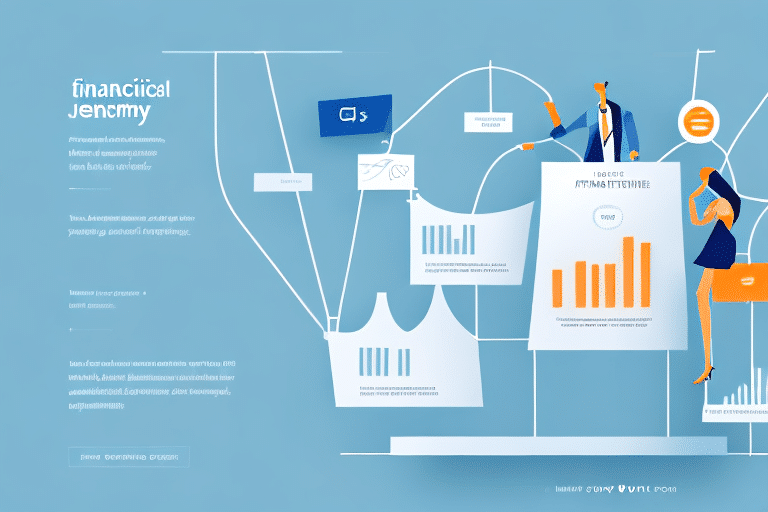Strategies for Improving Customer Retention in Financial Services
In today's highly competitive market, businesses need to go beyond acquiring new customers and focus more on retaining their existing ones. This holds true for financial services companies as well, where retaining customers is crucial for long-term success. In this article, we will explore various strategies for improving customer retention in financial services and discuss the importance of each one in detail.
Why Customer Retention Matters in Financial Services
Customer retention is the backbone of any successful business, and financial services companies are no exception. Retaining existing customers not only helps in boosting revenue but also saves the cost of acquiring new ones. According to a study by Bain and Company, a 5% increase in customer retention can lead to a 25-95% increase in profits for financial services companies. Additionally, satisfied customers are more likely to refer new customers, thereby reducing the cost of acquiring new customers.
Moreover, customer retention is crucial in building a strong brand reputation. When customers are satisfied with the services provided by a financial services company, they are more likely to become loyal customers and advocates for the brand. This can lead to positive word-of-mouth marketing, which is a powerful tool in attracting new customers and retaining existing ones.
Furthermore, customer retention can help financial services companies to identify areas for improvement. By analyzing customer feedback and complaints, companies can identify common issues and work towards resolving them. This not only helps in retaining existing customers but also in attracting new ones who are looking for a company that values customer feedback and is committed to improving its services.
Understanding the Customer Lifecycle
Understanding the customer lifecycle is essential for creating an effective retention strategy. The customer lifecycle comprises different stages, starting from awareness to advocacy. At each stage, customers have different needs and expectations. Understanding these needs and offering solutions accordingly can improve the customer experience and foster loyalty. The stages of the customer lifecycle include awareness, consideration, purchase, post-purchase, and advocacy.
Awareness
At this stage, customers become aware of your brand and products. They may have heard about your brand through advertising, social media, or word of mouth. It is important to create a strong brand image and communicate your unique value proposition to attract potential customers.
Consideration
At this stage, customers are evaluating your products or services and comparing them with your competitors. Providing detailed product information, offering demos or trials, and addressing customer concerns can help in converting potential customers into actual customers.
Purchase
At this stage, customers have made the decision to purchase your product or service. Providing a seamless and hassle-free purchase experience can improve customer satisfaction and increase the likelihood of repeat purchases.
Post-Purchase
At this stage, customers have already purchased your product or service and are using it. Providing excellent customer service, addressing any issues or concerns promptly, and offering post-purchase support can improve customer satisfaction and foster loyalty.
Advocacy
At this final stage, customers are satisfied with your product or service and are willing to recommend it to others. Encouraging customers to leave reviews, offering referral programs, and providing incentives for repeat purchases can help in turning satisfied customers into brand advocates.
Identifying the Factors Leading to Customer Churn
Customer churn is the rate at which customers stop doing business with a company. Identifying the factors that lead to customer churn is crucial for creating a retention strategy. Some of the common reasons for customer churn in financial services are high fees, poor customer service, lack of personalization, and complicated processes. By analyzing customer data and feedback, financial services companies can identify the factors leading to customer churn and take corrective measures to address them.
One of the most effective ways to identify the factors leading to customer churn is to conduct surveys and gather feedback from customers who have recently left the company. This can provide valuable insights into the specific pain points that led to their decision to leave. Additionally, analyzing customer behavior data can help identify patterns and trends that may indicate a high risk of churn.
Once the factors leading to customer churn have been identified, financial services companies can take a variety of corrective measures to address them. This may include improving customer service, simplifying processes, offering personalized solutions, and reducing fees. By taking proactive steps to address customer churn, financial services companies can improve customer retention rates and ultimately increase profitability.
The Importance of Offering Personalized Services
Personalization is one of the most effective ways to improve customer retention. Customers expect personalized services from financial services companies, and failure to do so could result in losing them to competitors. Personalized services include offering customized products, personalized communication, and tailoring services according to the customer's needs. Analyzing customer data and preferences can help in offering personalized products and services, resulting in higher customer satisfaction and retention.
Moreover, offering personalized services can also lead to increased revenue for financial services companies. By understanding the unique needs and preferences of each customer, companies can offer targeted promotions and upsell opportunities. For example, if a customer frequently uses their credit card for travel expenses, the company can offer them a travel rewards program or a higher credit limit for travel-related purchases. This not only increases customer loyalty but also drives revenue for the company.
Building a Strong Customer Service Culture
A strong customer service culture is essential for improving customer retention. Customers want to feel valued and appreciated, and providing exceptional customer service is the key to achieving this. Financial services companies can build a strong customer service culture by training employees, empowering them to make decisions, and rewarding exceptional service. Additionally, providing multiple channels for customers to provide feedback and addressing complaints promptly can go a long way in improving customer satisfaction and retention.
Another important aspect of building a strong customer service culture is to ensure that all employees understand the company's values and mission. When employees are aligned with the company's goals, they are more likely to provide exceptional service that reflects those values. It's also important to regularly assess and improve customer service processes to ensure that they are efficient and effective. This can involve gathering customer feedback, analyzing customer service metrics, and implementing changes based on the results. By prioritizing customer service and continuously improving processes, financial services companies can build a strong customer service culture that sets them apart from competitors.
Leveraging Technology to Improve Customer Retention
Technology has revolutionized the way financial services companies communicate with their customers. Leveraging technology can help in providing a seamless customer experience and improving retention. Some examples of using technology to improve customer retention include mobile banking apps, chatbots, and automated emails. These tools can improve efficiency, reduce wait times, and provide a convenient and personalized experience, resulting in higher customer satisfaction and retention.
Another way technology can improve customer retention is through the use of data analytics. By analyzing customer data, financial services companies can gain insights into customer behavior and preferences. This information can be used to personalize the customer experience, offer targeted promotions, and anticipate customer needs. Additionally, data analytics can help identify potential issues before they become problems, allowing companies to proactively address customer concerns and improve satisfaction.
Engaging Customers Through Social Media
Social media platforms provide an opportunity for financial services companies to engage with their customers and build brand awareness. Engaging with customers on social media can help in humanizing the brand, addressing customer queries and complaints, and promoting products and services. Moreover, social media can help in creating a community of loyal customers who can advocate for the brand and refer new customers.
One of the key benefits of social media is that it allows financial services companies to gather valuable feedback from their customers. By monitoring social media conversations, companies can gain insights into customer preferences, pain points, and expectations. This information can be used to improve products and services, and to tailor marketing messages to better resonate with customers.
Another advantage of social media is that it provides a cost-effective way to reach a large audience. Traditional advertising channels such as TV and print can be expensive, and may not be as effective in reaching younger, tech-savvy audiences. Social media, on the other hand, allows companies to target specific demographics and interests, and to create engaging content that can be shared and amplified by users.
Investing in Loyalty Programs That Work
Loyal customers are the backbone of any successful business, and loyalty programs can help in fostering customer loyalty. However, the success of a loyalty program depends on its design and implementation. Financial services companies need to invest in loyalty programs that offer value to the customer, are easy to understand, and have a clear reward structure. Additionally, loyalty programs should be personalized and tailored to the customer's needs and preferences.
Addressing Feedback and Complaints Effectively
Addressing customer feedback and complaints effectively is crucial for improving customer retention. Financial services companies need to have a robust feedback mechanism in place and must address complaints promptly. Additionally, a transparent and efficient complaint resolution process can go a long way in building customer trust and loyalty. By addressing feedback and complaints effectively, companies can show that they value their customers and are committed to providing exceptional service.
Staying Ahead of the Competition with Innovative Services
To stay ahead of the competition, financial services companies need to constantly innovate and offer new and innovative services. Analyzing customer data and feedback can help in identifying the gaps in the market and offering solutions accordingly. By offering innovative and unique services, companies can differentiate themselves from the competition, thereby improving customer retention and brand loyalty.
Measuring Your Success: Key Metrics for Evaluating Retention Efforts
Financial services companies need to measure the success of their retention efforts regularly. Some of the key metrics for evaluating retention efforts include:
- Customer Satisfaction: Measures how satisfied customers are with your services.
- Customer Retention Rate: The percentage of customers who remain with the company over a specific period.
- Customer Lifetime Value: The total revenue a company can expect from a single customer account.
- Referral Rate: The percentage of new customers acquired through referrals.
By monitoring these metrics, companies can identify areas of improvement and refine their retention strategy accordingly.
Case Studies: Successful Retention Strategies in Financial Services
Case studies of successful retention strategies in financial services can provide insights into best practices and successful implementation. Some examples include:
- American Express's Loyalty Program: Offers exclusive rewards and experiences that encourage customers to stay loyal.
- Chase's Mobile App: Provides users with convenient banking features, enhancing customer satisfaction and retention.
- Mint.com's Personal Finance Software: Offers personalized financial management tools that help users stay engaged with the platform.
By studying successful case studies, financial services companies can learn from the strategies that worked and avoid the ones that did not.
Conclusion: Putting It All Together for Long-Term Success
Improving customer retention is an ongoing process that requires constant effort, innovation, and commitment. By understanding the customer lifecycle, identifying the factors leading to customer churn, offering personalized services, building a strong customer service culture, leveraging technology, investing in loyalty programs, addressing feedback and complaints, staying ahead of the competition, and measuring success, financial services companies can create a robust retention strategy that fosters loyalty and improves long-term success.






















